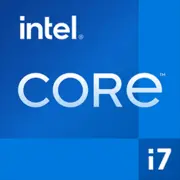Intel Core i7-1195G7

Intel Core i7-1195G7: 모바일 작업을 위한 다목적 프로세서. 2025년 전체 분석
소개
2021년에 출시된 Intel Core i7-1195G7 프로세서는 2025년에도 울트라북과 컴팩트 노트북을 위한 여전히 적합한 솔루션입니다. Intel, AMD 및 Apple의 새로운 CPU 세대가 등장했음에도 불구하고, 이 모델은 성능, 에너지 효율 및 가격의 우수한 균형 덕분에 여전히 그 입지를 유지하고 있습니다. 본 기사에서는 이 칩이 오늘날 누구에게 적합한지, 현대 작업을 어떻게 처리하는지, 장치를 선택할 때 유의할 점에 대해 분석해 보겠습니다.
아키텍처 및 공정: 10nm SuperFin 및 하이브리드 기술
타이거 레이크의 특징
Core i7-1195G7은 10nm SuperFin 기술을 기반으로 한 타이거 레이크 세대에 속합니다. 이를 통해 Intel은 이전 모델(아이스 레이크)에 비해 에너지 효율성과 클럭 속도를 향상시킬 수 있었습니다.
- 코어 및 스레드: 4코어, 8스레드(하이퍼스레딩). 2025년에는 다소 적은 코어 수지만, 프로세서는 높은 단일 스레드 성능에 중점을 두고 있습니다.
- 클럭 속도: 기본 클럭 — 2.9GHz, 터보 모드에서 최대 — 5.0GHz(단일 코어). 모든 코어는 부하 시 최대 4.6GHz까지 작동할 수 있습니다.
- 캐시: L3 — 12MB로, 오피스 및 멀티미디어 응용 프로그램에서 데이터 처리 속도를 높입니다.
인텔 아이리스 Xe 통합 그래픽
96 EU(실행 유닛)를 갖춘 iGPU 아이리스 Xe는 주요 장점입니다. 그래픽은 다음을 지원합니다:
- 4K@60Hz HDMI 2.0 또는 DisplayPort;
- AV1 및 VP9 하드웨어 디코딩을 통한 스트리밍;
- DirectX 12로, 낮은 설정에서 간단한 프로젝트에서 게임을 할 수 있습니다.
비교를 위해: 라이젠 5 5600U(Vega 7)의 통합 그래픽은 3DMark 테스트에서 20% 더 약합니다.
전력 소비 및 TDP: 성능과 배터리 수명 간의 균형
프로세서의 명목 TDP는 28W이지만, 실제 전력 소비는 OEM 제조업체의 설정에 따라 달라집니다. 예를 들어:
- 울트라북(예: Dell XPS 13)에서 TDP는 15-20W로 제한될 수 있어 열을 줄일 수 있습니다.
- 컴팩트 워크스테이션(HP EliteBook 840 G8)에서는 최대 성능을 위해 35W까지 오버클럭이 가능합니다.
전력 절약 기술:
- Intel 동적 조정 2.0 — 부하에 따라 자동으로 전력을 조정합니다.
- Adaptix — 특정 응용 프로그램에 대한 최적화(예: Zoom에서 클럭 속도 감소).
성능: 2025년 i7-1195G7의 능력은?
오피스 작업 및 멀티미디어
- 오피스: 문서 작업, 브라우저(20개 이상의 탭), 화상 회의 — 프로세서는 지연 없이 작업을 수행합니다. PCMark 10 테스트에서 약 4800점을 기록하며, 이는 Ryzen 7 5800U와 유사합니다.
- 사진 편집기: Photoshop 및 Lightroom은 원활하게 작동하지만, 복잡한 레이어 렌더링은 8코어 CPU보다 10-15% 더 많은 시간이 걸릴 수 있습니다.
- 비디오: DaVinci Resolve에서 1080p 편집은 가능하지만 4K 작업에는 디스crete 그래픽을 사용하는 것이 좋습니다.
게임
아이리스 Xe는 다음과 같은 게임을 실행할 수 있습니다:
- CS:GO — 중간 설정에서 60-70 FPS(1080p);
- Genshin Impact — 40-45 FPS(720p, 낮은 그래픽);
- Fortnite — 50-55 FPS(900p, 중간 설정).
Cyberpunk 2077 또는 Starfield와 같은 게임에는 외장 GPU(예: RTX 3050 Mobile)가 필요합니다.
터보 부스트 모드: 장단점
최대 클럭 속도 5.0GHz는 짧은 시간(최대 30초) 동안만 달성됩니다. 장기간 부하(렌더링) 시 프로세서는 냉각 시스템에 따라 3.8-4.2GHz로 안정화됩니다.
예시: 두 개의 팬이 있는 레노버 요가 슬림 7i에서는 부하 시 온도가 75°C를 초과하지 않지만, 더 얇은 에이서 스위프트 5에서는 90°C에 도달하여 스로틀링이 발생할 수 있습니다.
사용 시나리오: 이 프로세서는 누구에게 적합한가?
1. 학생 및 사무직 근무자 — 학습, 문서 작업 및 간단한 미디어 소비에 적합합니다.
2. 프리랜서 — 편집자, 디자이너 등 모바일성이 중요한 사람들.
3. 여행자 — 이런 CPU를 장착한 컴팩트 장치는 대개 1.3kg 미만입니다.
4. 일반 게이머 — 무리하지 않는 게임이나 클라우드 게이밍(GeForce NOW)에 적합합니다.
적합하지 않은 경우:
- 4K/8K로 작업하는 비디오 편집자;
- 외장 GPU 없이 스트리머;
- 무거운 시뮬레이션(ANSYS, SolidWorks)을 사용하는 엔지니어.
배터리 수명: 노트북은 얼마나 지속될까?
배터리 용량이 60Wh인 경우:
- 웹 서핑 — 8-10시간;
- 비디오(1080p) — 12시간;
- 부하(Photoshop + 브라우저) — 4-5시간.
팁: 저전력의 IPS 기반 디스플레이 모델(예: LG LP140WFA-SPD1)을 선택하고, 예산이 한정된 노트북에서는 OLED 화면을 피하세요 — 이들은 배터리 수명을 15-20% 감소시킵니다.
경쟁 제품 비교
AMD Ryzen 5 5600U (Zen 3)
- 장점: 6코어, 멀티스레드 작업에서 더 우수합니다.
- 단점: 그래픽은 약하며(Vega 7), 단일 스레드 테스트에서 클럭 속도가 떨어집니다(Geekbench 6 단일 코어 — 약 1500점).
- 노트북 가격: $600-800(2025).
Apple M1
- 장점: 뛰어난 에너지 효율성(18시간 배터리 수명), 빠른 SSD입니다.
- 단점: Windows 프로그램과의 호환성 제한입니다.
- 가격: MacBook Air M1 — $899(새 제품).
Intel Core i7-1260P (Alder Lake)
- 장점: 12코어(4P + 8E), 멀티스레드 성능이 30% 향상되었습니다.
- 단점: 가격이 더 높습니다(노트북 $1000 이상).
i7-1195G7의 장단점
강점:
- 높은 단일 스레드 성능;
- 강력한 통합 그래픽;
- Thunderbolt 4 및 Wi-Fi 6 지원;
- 적정 가격(장치 $700부터).
약점:
- 4코어만으로 인해 멀티스레드 작업에서 Ryzen 및 Alder Lake에 비해 뒤떨어집니다;
- 얇은 몸체에서의 열발생;
- PCIe 4.0 미지원(단지 PCIe 3.0만 지원).
노트북 선택 시 권장 사항
1. 장치 유형: 울트라북(Asus ZenBook, HP Spectre x360) 또는 비즈니스 노트북(Lenovo ThinkPad X1 Carbon).
2. 냉각 방식: 두 개의 팬과 구리 열교환기가 있는 모델을 찾으세요.
3. 화면: Full HD 또는 2.5K의 주사율 60Hz. 그래픽 작업을 위해선 100% sRGB 지원.
4. 메모리 및 SSD: 최소 16GB RAM 및 512GB NVMe SSD.
2025년 모델 예시:
- Dell Inspiron 14 7420 ($750): 16GB RAM, 512GB SSD, 14인치 화면.
- MSI Prestige 14 Evo ($900): 개선된 냉각 시스템, Thunderbolt 4.
최종 결론
Intel Core i7-1195G7은 작업과 오락을 위한 좋은 성능을 갖춘 컴팩트 노트북을 찾는 사람들에게 훌륭한 선택입니다. 이 프로세서의 주된 장점은:
- 사무실, 학습 및 여행에 이상적;
- 간단한 게임 및 편집도 가능;
- 2025년에 경쟁 제품에 비해 20-30% 저렴한 가격.
구매 권장 대상: 학생, 프리랜서 및 성능과 휴대성 간의 균형을 중요시하는 사용자들입니다. 더 높은 성능이 필요한 작업의 경우, Ryzen 7 6800U 또는 Core i5-1340P가 장착된 노트북을 고려하는 것이 좋습니다.
기초적인
CPU 사양
메모리 사양
GPU 사양
여러 가지 잡다한
벤치마크
다른 CPU와 비교
소셜 미디어에서 공유하기
또는 링크로 소개하기
<a href="https://cputronic.com/ko/cpu/intel-core-i7-1195g7" target="_blank">Intel Core i7-1195G7</a>